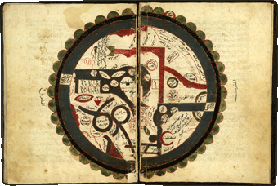Mystics and Saints of Islam
 By Claud Field
By Claud Field
Note: This fascinating work was first published in London in 1910. While minor editing changes have been made to enhance readability for a modern American audience, we have left a number of terms that are at best regarded as anachronistic. No offense is intended. It is a choice of being historically correct, as opposed to politically correct, and the usage of such terms should be regarded simply as an example of terminology used by Western authors writing in English at the beginning of the 20th century.
Contents
I. |
PANTHEISTIC SUFISM |
|
II. |
HASAN BASRI
|
|
III. |
RABIA, THE WOMAN SUFI
|
|
IV. |
IBRAHIM BEN ADHAM
|
|
V. |
FUDHAYL BEN AYAZ
|
|
VI. |
BAYAZID BASTAMI
|
|
VII. |
ZU’N NUN OF EGYPT
|
|
VIII. |
MANSUR HALLAJ
|
|
IX. |
HABIB AJAMI
|
|
X. |
AVICENNA (IBN SINA)
|
|
XI. |
AL GHAZZALI
|
|
XII. |
FARIDUDDIN ATTAR
|
|
XIII. |
SUHRAWARDY
|
|
XIV. |
JALALUDDIN RUMI
|
|
XV. |
SHARANI, THE EGYPTIAN
|
|
XV. |
MULLAH SHAH |
APPENDIX |
I. |
MUSLIM CONVERSIONS
|
|
“ |
II. |
EXPOSITION OF SUFISM
|
|
“ |
III. |
CHRISTIAN ELEMENTS IN MUSLIM LITERATURE
|
|
“ |
IV. |
CHRIST IN MUSLIM TRADITION |
PREFACE
It is a custom in some quarters to represent Islamic mysticism as merely a late importation into Islam, and an altogether alien element in it. But however much later Islamic mysticism may have derived from Christian, Neo-platonic, and Buddhist sources, there is little doubt that the roots of mysticism are to be found in the Koran itself. The following verse is an instance: “God is the Light of the heavens and the earth. His light is like a niche in which is a lamp, the lamp encased in glass—the glass as it were a glistening star. From a blessed tree is it lighted, the olive neither of the East nor of the West, whose oil would well-nigh shine out even though fire touched it not! It is light upon light!” (Koran Sura 24).
Indeed it seems strange to accord the title of “a practical mystic” to Cromwell and to deny it to Muhammad, whose proclivity for religious meditation was so strong that the Arabs used to say “Muhammad is in love with his Maker,” and whose sense of the “terror of the Lord” was so intense that it turned his hair prematurely white. Many of the reported sayings of the Early Companions of Muhammad show that they shared this terror. “Verily, you shall see hell, you shall see it with the eye of certainty” says the Koran, and they thought it very probable. Thus Ali exclaimed “Alas for the shortness of the provision and the terrors of the way!” Abu’l Darda said “If ye knew what ye shall see after death, ye would not eat nor drink, and I wish that I were a tree that is lopped and then devoured.”
This “fear of the Lord” led naturally to an almost fierce asceticism. Abu Bekr and Ali both founded communities of ascetics, and during the first and second centuries of Islam there were many orthodox mystics. Professor Nicholson in the work just quoted, rightly says “I do not think that we need look beyond Islam for the origin of the Sufi doctrines…. The early Sufis are still on orthodox ground, their relation to Islam is not unlike that of the medieval Spanish mystics to the Roman Catholic Church.”
